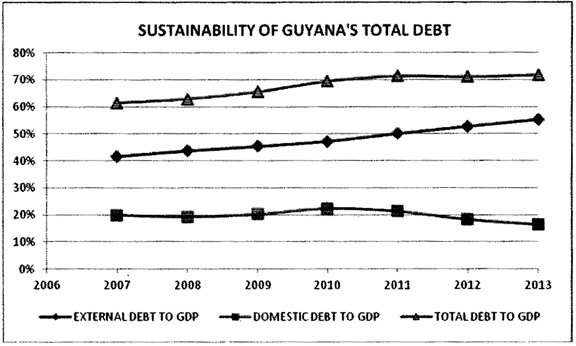Dear Editor,
Mr Moses Nagamootoo had reason a few weeks ago to raise the debt sustainability issue in Parliament, albeit his focus was on the nominal Guyana dollar debt being the biggest debt ever in the history of post-colonial Guyana. The point that he made was that the nominal Guyana dollar debt today was bigger than it was in the PNC days. Well from the Minister’s own admission, Mr Nagamootoo was factually correct on the nominal numbers since his source was none other than the Minister’s own words. However, the Minister of Finance did issue a rejoinder that the traditional measure of debt is the debt to GDP ratio.
This tradition came from the Washington economists who prefer to use the external debt to GDP ratio when they are assessing the sustainability of a nation’s debt. But in Guyana’s case, even that indicator remains inadequate since the nation has a considerable domestic debt in addition to the external debt.
The chart below clearly outlines the trajectory of the nation’s total debt to GDP ratio (the top line). The figures were sourced from the IMF and the Bank of Guyana reports. Please pay close attention to the middle line (the nation’s external debt to GDP trajectory) and the bottom line which reflects the state of affairs on the domestic debt.
 When the President reinforced the Minister’s position at Babu Jaan at Cde Cheddi Jagan’s 16th Memorial, one had no other choice but to correct these political gaffes that we are doing better on the national debt. We certainly are not!
When the President reinforced the Minister’s position at Babu Jaan at Cde Cheddi Jagan’s 16th Memorial, one had no other choice but to correct these political gaffes that we are doing better on the national debt. We certainly are not!
The total national debt remains a real clear and present danger on the bread and butter issues to the children of Guyana. At least the majority of the university graduates are fully aware of this maha-iceberg approaching the Guyana Titanic. At last count some 85% of them are migrating out of the country on an annual basis to safer economies. But where will Jagan’s people (the poor, the working class and the vulnerable) go?
In 1992 Dr Jagan’s primary goal was to make continuous down payments on the nation’s future by taking concrete action on the budget deficit, spending a bigger share of the budget on the poor, the working class and the vulnerable, and turning around the clock on the PNC debt crisis. He successfully prepared the foundations to achieve these ambitions during his tenure. Therefore, why are we here today with a wider than ever budget deficit and the largest ever total national debt?
Guyana is at risk for debt distress and we can slice it or dice it how we want (nominal number, debt to GDP ratio, partial reporting), the facts remain unchanged. This is the time for all politicians regardless of affiliation to act responsibly and work together to arrest these acts of pawning the future of the Guyanese children with the ‘loan sharks,’ as was done in the PNC days. That means the upcoming budget must be maturely reduced to reflect our ability to fund it with more of our money and less of the bankers’ money.
Anyone who understands finance clearly knows the Skeldon Sugar Factory, the ICT cable project, most of the new GPL transmission and distribution project, the new airport expansion, and the Chinese ferry are all owned by the Chinese, in whole or in part. That is some $57,941 million in new debt borrowed in less than four years from the Chinese, much of which has to be repaid with interest by the children of Guyana. How different is this financial recklessness from the PNC days?
Debt is debt regardless if the bank is American or Chinese. The interest will build up and our debt service costs are going to increase rapidly very soon. So all this talk of expanding the economy to pay the workers a better salary in the near future is just a political carrot that has no basis in fact. These increasing demands on the Treasury from the banks will steal resources from the people that were supposed to fund increases in wages, the training of teachers and nurses, taking care of the poor and the most vulnerable and so on.
From the modelling some of us have done, it is clear as crystal that this 5% growth model of the Ramotar administration will deny the poor and the most vulnerable improvement in their economic well-being for the next 50 years. Many of them will die before they can dream of sharing in the riches that Guyana possesses. Was this the dream Cheddi Jagan had for them when he ran for office in 1992?
Yours faithfully,
Sasenarine Singh

